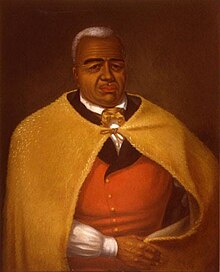Kamehameha I.
Kamehameha I, the Great (* 1758 (?); † 1819 ) was the first king of Hawaii (1795-1819).
Legends claimed that one day a great king would unite the Hawaiian Islands. The sign of his birth will be a comet. Since Halley's Comet could be seen from Hawaii in 1758, it is assumed that this was the year Kamehameha I was born.
Kamehameha I was the nephew of Kalaniʻopuʻu , the chief of the island of Hawaii , in whose attempted arrest James Cook was killed. After the death of Kalaniʻopuʻu in 1782, his son Kiwalao became chief of the Big Island. Kamehameha had a high religious position and became guardian of the god of war Kukailimoku .
In the years after the death of Kalani'opu'u, there were several arguments between the cousins, without either of them being able to gain the upper hand. In 1786, Kahekili , King of Maui , was at the height of his power. Besides Maui, he not only ruled Oʻahu , Molokaʻi and Lānaʻi , but also controlled Kauaʻi and Niʻihau through an agreement with his half-brother Kaʻeokulani . In 1790 Kamehameha succeeded in defeating Kahekili, but he was not yet able to consolidate his power permanently. In further campaigns, which soon also included Oahu, Kamehameha cleverly secured the support of foreigners such as Isaac Davis , John Young and George Vancouver . In this way he came into possession of firearms, which gave him more and more the superiority.
When in 1810 Kaumualiʻi , the chief of Kauaʻi, finally submitted, Kamehameha was the sole ruler of the island group.
As king, he took several steps to ensure that the islands would remain a united kingdom after his death. After the wars, Kamehameha I was considered a benevolent and generous king and was revered by the people.
Kamehameha standardized the legal system and exported raw materials (including sandalwood ) to promote trade with Europe and the USA . This ensured the independence of the islands while other islands in the Pacific had to submit to the colonial powers . In fact, the Hawaiian Kingdom retained its independence, with the exception of a brief five-month occupation in 1843, until it was annexed by the United States in 1898.
Others
- The Order of Kamehameha I was in 1864 by Kamehameha V. donated.
- Several bronze statues of Kamehameha I can be found in various locations in Hawaii. Not only are they symbols of Hawaii, but are viewed by many Hawaiians as objects of spiritual worship. One cast is in the National Statuary Hall Collection of the Capitol in Washington, DC
- In the 1960s, the United States Navy named the submarine USS Kamehameha (SSBN-642) after him.
- In the television series Magnum , a club is named after him, the King Kamehameha Club . This fictional club in turn is the namesake for the King Kamehameha Club in Frankfurt am Main.
- In the Japanese manga and anime series Dragonball , Kamehameha is the name of a powerful energy attack.
Web links
Individual evidence
- ↑ a b Linda Wedel Greene: A Cultural History of Three Traditional Hawaiian Sites on the West Coast of Hawai'i Island (Chapter 4)
| personal data | |
|---|---|
| SURNAME | Kamehameha I. |
| ALTERNATIVE NAMES | Kamehameha I, the great |
| BRIEF DESCRIPTION | King of Hawaii (1795–1819) |
| DATE OF BIRTH | around 1758 |
| PLACE OF BIRTH | Hawaii |
| DATE OF DEATH | 1819 |
| Place of death | Hawaii |

